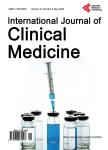Papillary Muscle Function Does Not Predict Mitral Regurgitation in Patients with Normal Left Ventricular Systolic Function: A Transesophageal Echocardiographic Study
Papillary Muscle Function Does Not Predict Mitral Regurgitation in Patients with Normal Left Ventricular Systolic Function: A Transesophageal Echocardiographic Study作者机构:不详
出 版 物:《International Journal of Clinical Medicine》 (临床医学国际期刊(英文))
年 卷 期:2011年第2卷第2期
页 面:178-183页
主 题:Mitral Regurgitation TEE Papillary Muscle LV Function
摘 要:Objective: To evaluate LV papillary muscles (PM) function using transesophageal echocardiography (TEE), and to determine the relationship between PM function and mitral regurgitation in patients with normal left ventricular sys-tolic function. Design: TEE examinations were prospectively performed. End diastolic and end systolic PM lengths were obtained from the transgastric long axis views and fractional systolic shortening (FS) was calculated. LV ejection fraction was determined using modified Simpson rule and mitral regurgitation was determined using regurgitant jet area by color flow. Setting: Tertiary Center. Patients: 85 consecutive adult patients (51 with mitral regurgitation and 34 without) with normal LV chamber dimensions and LV systolic function, meeting enrollment criteria. Results: The % FS in patients with mitral regurgitation was 21.7 ± 3.6% for anterior PM (APM) and 18.7 ± 4.6% for posterior PM (PPM). In those without mitral regurgitation, the values were as follows;22.6 ± 5.4% (APM) and 19.5 ± 3.8% (PPM). In a subgroup of patients with severe mitral regurgitation (n = 23), the values for PM FS were 20.3 ± 6.8 (APM) and 18.4 ± 6.9 % (PPM). There was no statistically significant difference in PM fractional shortening between the groups. Anterior papillary muscle length was longer in those patients with mitral regurgitation compared to those without [(End-diastolic length (cm): 3.38 ± 0.61 v 2.88 ± 0.47(p: 0.008) and end-systolic length of 2.46 ± 0.51 v 2.17 ± 0.33 (p: 0.04)]. These differences are more pronounced in those with severe mitral regurgitation (p: 0.002 and 0.004 for EDL and ESL respectively. Conclusion: In patients with normal LVEF, PM contraction is similar in those with and without MR. In patients with MR however, anterior PM length (ED & ES) is significantly increased. Our data suggests that in patients with normal LVEF, PM dysfunction appears to play no significant role in the causation of MR. Anterior papillary muscle length however, appears to be a major determinant of mitral regurgitation in such patients.



